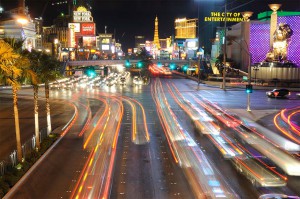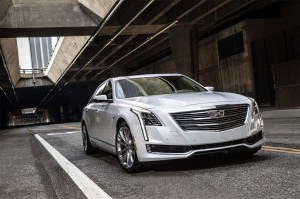
Audi is partnering with Las Vegas to use V2I technology to help Audi drivers avoid traffic congestion.
Driving down the Las Vegas “Strip” can be a maddening affair, with long lines of cars and seemingly endless waits for traffic signals to turn green. But Audi wants to de-stress the situation, at least a little, by alerting drivers when those lights are about to change.
Sit behind the wheel of a 2017 Audi A4, Q7 or Allroad and you’ll notice an icon on the instrument panel shaped like a traffic light. Come up on a red light when driving through Las Vegas and a timer next to the icon will begin to count down. As if by magic, when the number reaches “0,” the light will go green.
That’s because Audi has tied into a new Vehicle-to-Infrastructure, or V2I, system designed to help motorists keep track of local road conditions, starting with traffic light information for Clark County, an 8,100 square-mile area that includes the City of Las Vegas. Similar V2I systems, as well as Vehicle-to-Vehicle, or V2V, technology, could soon become commonplace across the U.S.
“We applaud the innovative approach of Las Vegas in working with us on V2I,” said Scott Keogh, the CEO of Audi of America.
Audi is laying claim to being the first automaker to build V2I technology into some of the vehicles it is selling in the U.S. The system relies on the same 4G LTE system many Audi models already use to download Google maps and to give drivers a built-in WiFi hotspot.
The Traffic Light Information feature is part of Audi’s PRIME infotainment service and will eventually be activated in cities across the U.S. But Clark County became the first because it now has all of its stop lights linked to a single, centralized traffic management center covering a region nearly as big as the State of New Jersey.

If you're behind the wheel of the new Audi A4, it can help you avoid traffic delays — at least in Las Vegas.
Using GPS, a vehicle using the service knows when it is coming up on an intersection and whether there’s a traffic signal that’s turned red or green. Drivers will no longer have to crane their necks to see the light, especially if they’re stuck behind one of the ubiquitous tour buses rolling down the casino-lined Strip.
The V2I system also will alert an Audi driver if an upcoming light is going to turn red before they make it to the intersection, allowing them to relax and brake more smoothly.
(Audi gets sporty with new2 A5 and S5 Sportback. Click Here for the story.)
“A lot of behavior in the car changes,” Audi executive Pom Malhotra told the Associated Press during a demonstration of the system. “You have time to relax your hands and shoulders … time to hand a milk bottle to your child in the back seat … while knowing you’re not taking attention away from the road.”
A total of 1,300 stoplights are covered by Clark County’s FAST system, shorthand for the Freeway and Arterial System of Transportation. It also takes in 508 cameras, freeway traffic flow detectors, on-ramp meters and more than 100 message boards.
As in many cities, FAST already provides information on traffic conditions that can be used to warn motorists of tie-ups. Some vehicles even can plot detours based on that information. But the Audi V2I system takes the data to a new level.
In the future, other information, such as weather conditions, could be beamed to Audi vehicles. In other parts of the country, that would be useful should infrastructure monitors detect, for example, white-out conditions during a snowstorm.
(Click Here for more about Audis talking to U.S. traffic signals.)
Other automakers are planning to get in on the act. Cadillac plans to add a V2V system that will link owners of the new CT6 sedan, for one.
Meanwhile, the federal government has begun setting up a V2I network that will cover major roadways within a several 100 square mile grid covering metropolitan Detroit. The goal is to eventually expand that nationwide.
Proponents of so-called V2X technology contend it will ultimately help improve traffic flow, reduce fuel consumption and help save lives.
“This vehicle-to-infrastructure technology will help reduce congestion and enhance mobility on our already crowded roadways,” said Tina Quigley, General Manager of the Regional Transportation Commission of Southern Nevada.
(Audi sued, facing possible probe over cheating on gasoline emissions tests. Click Here for the story.)
Such systems are also considered an essential element in launching autonomous and even driverless vehicles in the coming years.

